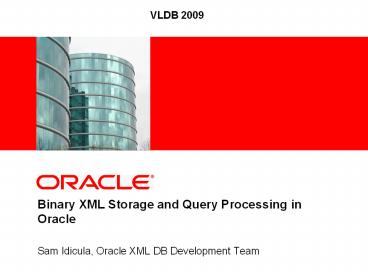Sam Idicula, Oracle XML DB Development Team - PowerPoint PPT Presentation
1 / 21
Title:
Sam Idicula, Oracle XML DB Development Team
Description:
This presentation contains information proprietary to Oracle Corporation ... Binary XML Storage and Query Processing in Oracle Sam Idicula, Oracle XML DB Development Team – PowerPoint PPT presentation
Number of Views:167
Avg rating:3.0/5.0
Title: Sam Idicula, Oracle XML DB Development Team
1
Binary XML Storage and Query Processing in Oracle
VLDB 2009
- Sam Idicula, Oracle XML DB Development Team
2
Outline
- Motivation
- Binary XML Overview
- Storage Format Details
- Query Processing
- Performance Evaluation
- Conclusion
3
Previous Oracle XML Storage Models
- CLOB Storage
- Text representation preserves exact form of
original document (including white spaces) - Very good performance for insert full retrieval
- Size bloat (including tags, string representation
of dates, numbers etc) - Need to parse the document for all XML processing
- Query DML processing are not efficient
- Memory overhead with DOM
- Mid-tier does not take advantage of parsing and
validation already done on DB tier (and
vice-versa)
4
Previous Oracle XML Storage Models
- Object Relational Storage (OR)
- XML Schema-based mapping to object-relational
tables - Preserves DOM fidelity (more than traditional
shredding) - Simple XPaths translate to table/column access
- Very good query performance for highly structured
use cases - Flexibility is limited due to schema dependency
- Insert, full retrieval etc are poor (expand on
this separate these into 2 slides)
5
Motivation/Goals for Binary XML
- Bridge the gap between two extremes
- Structure-unaware text representation Full
flexibility, poor query performance - Object-relational mapping Heavily dependent on
rigid structure - Several customer use cases fall in between these
extremes - Native format that can
- Handle full spectrum of XML database use cases
- Optimized semi-structured use cases
- Provide good performance for a wide variety of
operations - Retain flexibility advantage of XML data model
while providing good performance
6
Customer use cases
High Flexibility
Majority of semi-structured customer use cases
Low Flexibility
7
Motivation/Goals for Binary XML
- XML Schema usage
- Need to be efficient for query processing on
schemaless loosely structured schemas - Ability to use schema constraints for more
efficient processing - Provide good performance for a wide range of
operations - Query
- DML Insert/Load, Partial (piecewise) update
- Full-document fragment retrieval
- Schema Validation Evolution
- Mid-tier integration
8
Oracle Binary XML Overview
- Compact Schema-aware XML Format
- Pre-parsed tokenized binary representation
- Addresses space-bloat associated XML 1.x
serialization - Intended for use in all tiers of Oracle stack
- Oracle XML DB
- Oracle iAS / XDK Java
- Exploits XML Schema information if available
- Also supports non-schema-based encoding
- Preserves Infoset or Data Model fidelity Not
bytes - Can create an XML Index for query optimization
9
Oracle Binary XML
WebCache
AppServer
Database
Client
Oracle Binary XML
- Mid-tier Processing Oracle XDK Java support
- Binary XML allows direct access to
fragments/sub-trees - XML processing optimization Scalable mid-tier DOM
10
Format Details
- Opcodes roughly corresponding to SAX events
- Each opcode has fixed number of operands
- Document-ordered serialization of opcodes
- Stored as a BLOB
- Tag names are tokenized into qname IDs
- Central repository (or)
- Inlined definitions
- Optimized opcodes for simple elements, repeating
elements etc. - Uses native data-types in the presence of XML
schema
11
Streaming Capabilities
- Streaming XPath evaluation
- XPathTable with NFA Multiple XPaths evaluated in
a single pass - Forward axes
- Streaming partial updates
- Most common update scenarios handled in streaming
manner - eg updateXML( /purchaseOrder/Reference/text()
, XXXX) - Can be directly applied on disk avoiding
expensive DOM construction - Takes advantage of the Oracle SecureFile LOB
storage to perform delta update
12
Query Processing Architecture
XQuery
SQL/XML
DB XQuery Rewrite
XMLIndex
Functional Evaluation (Streaming XPath)
Path-based XMLIndex
Table-based XMLIndex
Binary XML
13
Document-level Summary
- Long-term goal Efficient tree-oriented
navigation - Important for query execution
- Pure streaming is too costly over large documents
- Current Implementation
- Start end offsets for large subtrees
- Threshold for large can be adjusted
- Used for skipping to end of subtree
- Working on significant enhancements
- Handling all axes
14
Search-based Decoder
- Goal Search for a simple XPath or XPath location
step in a Binary XML stream - Main search params are (axis, qname ID)
- Supports wild cards
- OR of multiple qnameIDs allowed
- Return only when theres a result or search is
done - Skip irrelevant subtrees
- Using summary if possible
- Schema-aware search
- Can search for kidnum or child-position instead
of qname ID - Can terminate search earlier based on schema
15
Schema-aware NFA
- Goal Evaluate multiple XPaths in single pass
over document - Uses Y-Filter-like approach to build NFA
- Works in conjunction with search-based decoder
- Translates transitions to searches when possible
- Push unbranched linear state transition paths
into search-based decoder - Uses XML schema when available
- Use of kidnum instead of qname ID
- Sequence Occurrence constraints
- Derives a strict sequential constraint
16
Performance Query - XMark
- Ratio of elapsed time geometric mean for 100M
XMark doc - SB Schema-based
- NSB Non-schema-based
- CLOB is 144x
- No indexes
17
Performance Insert
- Ratio of elapsed time for XMark 10M doc
- SB Schema-based
18
Performance Full Retrieval
- Ratio of elapsed time for XMark 10M doc
- SB Schema-based
19
Performance Compression
- D1 Structured
- D2 Semi-structured
- D3 Document-centric
- Based on actual customer datasets mix of XML
document sizes - Further compression possible via SecureFile LOB
compression
20
Summary
- Binary XML
- Native XML storage format
- Handle full spectrum of XML use cases
- Schema-aware
- Query Processing Optimizations
- Search-based Decoder
- Document-level Summary
- Performance Results
21
For more information
- Contact
- Sam.Idicula_at_Oracle.com
- Downloads, technical documentation
- http//www.oracle.com/technology/tech/xml/xmldb/
index.html































